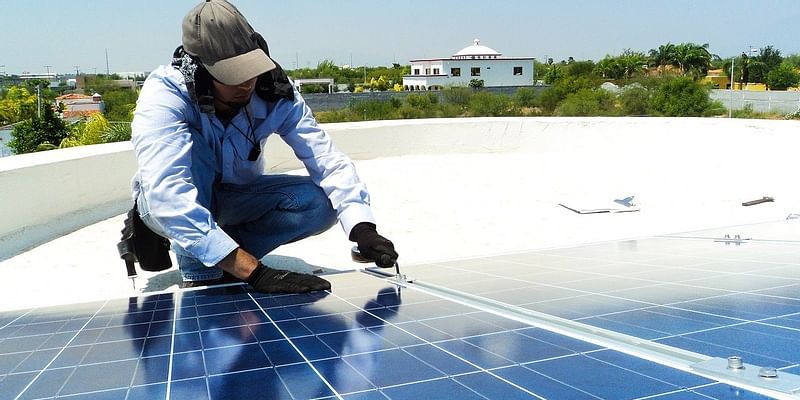Prime Minister Narendra Modi on Thursday said India will offer production-linked incentives for high-efficiency solar modules to boost the generation of electricity from renewable sources, which has the potential to generate an annual business of $20 billion.
Speaking at the RE-Invest 2020 conference, he invited global investors to join India's renewable energy journey.
"There are huge renewable energy deployment plans for the next decade," he said, adding that these are likely to generate business prospects of the order of around $20 billion per year.
"Today, India's renewable power capacity is the fourth largest in the world. It is growing at the fastest speed among all major countries," he said.
At current exchange rates, $20 billion translates to around Rs 1.5 lakh crore and Rs 15 lakh crore in a decade.
Renewable energy capacity will rise to 220 GW by 2022 from the current 136 Giga Watts (GW), he added. At present, renewable energy capacity is about 36 percent of the country's total electricity generating capacity.
Modi said that after the success of Production Linked Incentives (PLI) for electronics manufacturing, "we have decided to give similar incentives to high-efficiency solar modules". He, however, did not elaborate.
The prime minister also stressed that ensuring "ease of doing business" is our utmost priority and dedicated project development cells have been established to facilitate investors.
"In the last six years, we increased our installed renewable energy capacity by two-and-a-half times," he said. "Our annual renewable energy capacity addition has been exceeding that of coal-based thermal power since 2017".
Even when it was not affordable, investments were made in renewable energy. Now, investments and scale are bringing costs down, he said.
Noting that in the last six years, India has been travelling on an unparalleled journey, Modi said, "we are expanding our generation capacity and network to ensure every citizen of India has access to electricity to unlock his full potential".
He also emphasised that "we are showing to the world that sound environmental policies can also be sound economics".
"We have ensured energy efficiency is not limited to one ministry or department. Instead, it has been made a target for the entire government. All our policies have a consideration of achieving energy efficiency," Modi emphasised.

Image source: Pixabay
He inaugurated the third Global Renewable Energy Investment Meeting and Expo (RE-Invest 2020) through video conferencing. The summit is being organised by the Ministry of New and Renewable Energy, and this year's theme is 'Innovations for Sustainable Energy Transition'.
Power Minister RK Singh said that India has transformed from being energy deficit to being energy surplus, connected the entire country with one grid and connected 28 million households in 18 months, which is the largest programme in the whole world.
India's Intended Nationally Determined Contributions (INDCs) state that 40 percent energy production would be from non-fossil fuel sources.
Singh said that India currently has 38.1 percent installed capacity from non-fossil fuel sources.
By 2030, India plans to achieve 64 percent power generation capacity from renewable sources, which would be 24 percent higher than our commitment under Paris Agreement, he added.
The minister said that India is the only G20 country to take actions set to keep the increase in temperature below 2 degrees celsius. New technologies like green hydrogen and green urea would help in electrifying other major sectors of the country.
Dan Joergenson, Minister for Climate, Energy & Utilities, Denmark, said that India's target for renewable energy sends out a strong signal to the industry and the world that "you are committed to greening of the country".
Denmark will be developing the first energy island by 2030, he added.
At the inaugural session, Alok Sharma, President, COP26 and Secretary, Department of Business, Energy & Industrial Strategy, UK said there is a need to de-carboniase the economy five times faster than we have done in the past.
He said that India is a key partner as the country has led the way for a renewable energy revolution through the conception of ISA (International Solar Alliance), increasing its renewable energy capacity by 13 times in the last five years, achieving the lowest tariffs, leading the largest energy access plan and much more to come.
According to him, the UK has been able to reduce 43 percent of its emissions and houses the largest offshore wind project.
In his video message, Mark Rutte, Prime Minister of the Netherlands, said, that India leads in climate change and renewable energy, and both the countries have been firm supporters of Paris Agreement and ISA members.
He said that COVID-19 crisis has hit the society hard and all countries have realised that green investment is the way forward, which will make economies more resilient and reshape the future of energies.
In February 2021, the Netherlands will bring in a virtual trade Mission to India to discuss about water and renewable energy and travel across India.
Benjamin Netanyahu, Prime Minister of Israel, said that future of the world is clean energy. He said that at present, 10 percent of energy consumed by Israel comes from solar source and the target is to increase it to 25 percent by 2030.
The major issue is storage and about 400 startup companies are working in this space with billions of dollars of investment. These startups are expected to bring solutions that will benefit people across the world, he noted.
RE-INVEST 2020 will feature a three-day conference on renewables and future energy choices, and an exhibition of manufacturers, developers, investors, and innovators.
Edited by Megha Reddy
Link : https://yourstory.com/2020/11/india-incentives-solar-modules-renewable-energy-modi
Author :- Press Trust of India ( )
November 27, 2020 at 11:17AM
YourStory

